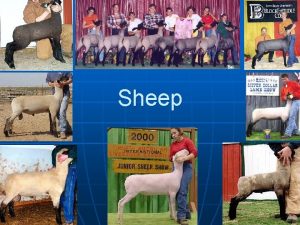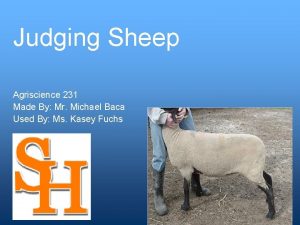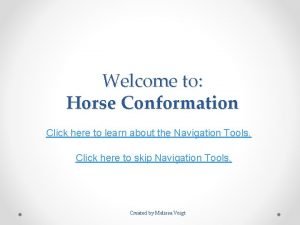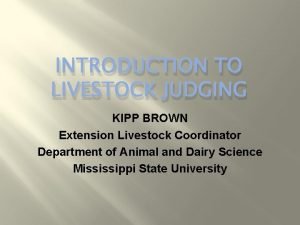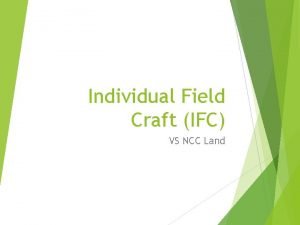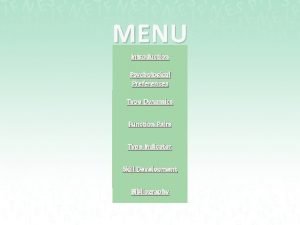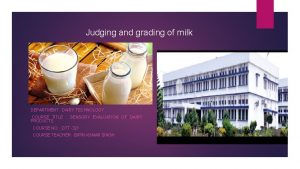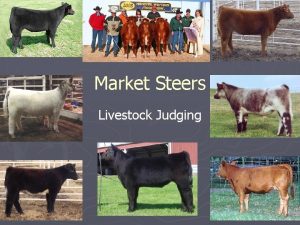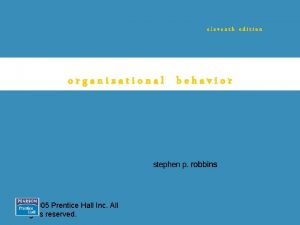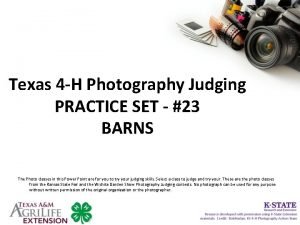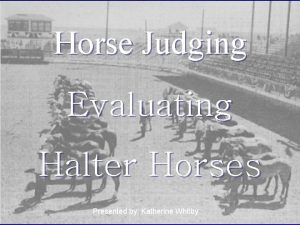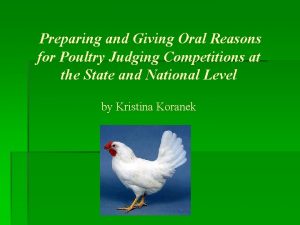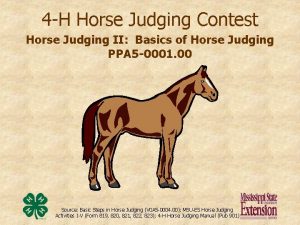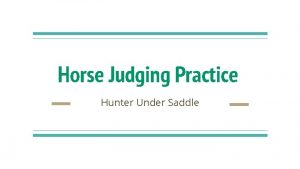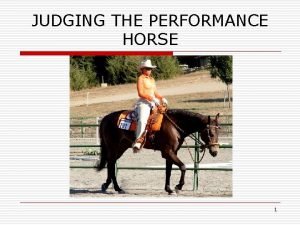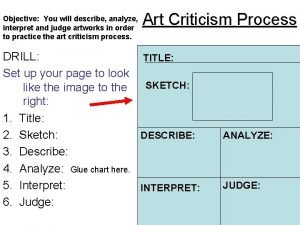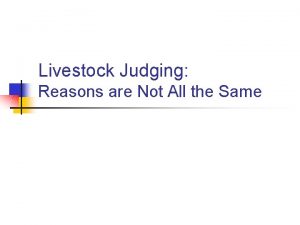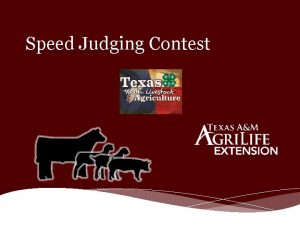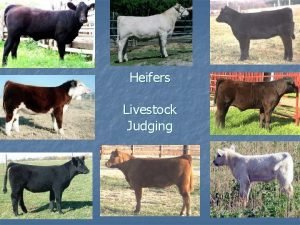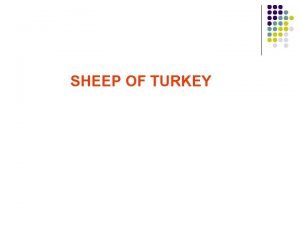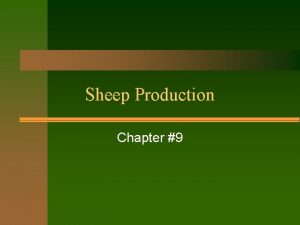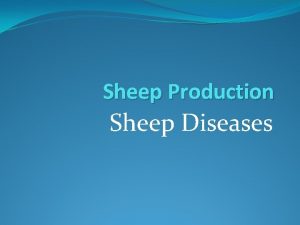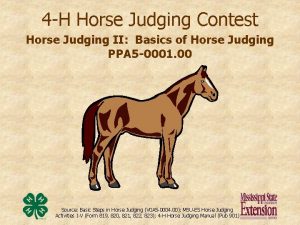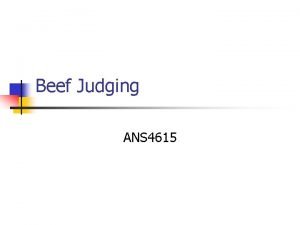Sheep Steps to Judging Sheep n n n



































- Slides: 35

Sheep

Steps to Judging Sheep n n n When judging sheep, the evaluation should begin from the ground and then working your way up, and then from the rear and working your way forward. The animals in the class should be ranked based on the traits of importance they possess, while putting the greatest emphasis on the most valuable traits in the production of sheep. Contestants should also eliminate any easy placings in the class, and place the remainder of the class based on the volume of the important traits.

Ranking of Traits for Market Lambs n The ranking of traits in the order of their importance for market lamb judging is as follows: n Degree of muscling n n Degree of finish Balance and style n n Frame size Soundness and structural correctness

Ranking of Traits for Breeding Sheep n The ranking of traits in the order of their importance for judging breeding ewes is as follows: n Balance and style n n Frame size Soundness and structural correctness n Capacity or volume n Degree of muscling n Degree of leanness n Wool

Evaluating Degree of Muscling n n Degree of muscling should first be evaluated through the center of the leg for thickness. The second place to examine the lamb is width between the rear feet when it is on the move or standing. It is very important to compare base width, or width at the ground, to top width, and in heavy muscled lambs these should be equal. Be careful to not be tricked by additional thickness due to fat cover. Visually judging tops can be very risky, and is not recommended on fat animals. Other areas to evaluate when determining degree of muscling include length of hindsaddle (the loin and the leg), width and length of loin, and the shape over the rack (a grooved shape to the rack is desired)

Evaluating Degree of Muscling Center Leg and Base Width Light Muscled (narrow) Average Muscled (average width) Heavy Muscled (wide) • These three pictures show lambs that are light muscled, average muscled, and heavy muscled. Note the differences among these lambs in thickness through the center of the leg and base width. The heavy muscled lamb on the far right shows the muscle shape that is desired, being extremely thick through the leg and having a square, wide top shape.

Handling Market Lambs • The purpose of handling sheep is to provide confirmation of what your eyes have already told you. • If given the option in a contest, you should always take advantage of the opportunity and handle each of the sheep in the class. • Occasionally, you will find that a visual appraisal alone did not give a true picture of a lamb's true muscling and finish. • The following pages describe the procedure you should use when handling sheep.

Handling Market Lambs The first place to handle a lamb is down its top. Place an open hand over the top of the shoulders to feel for neatness (or the lack of neatness) of the shoulder at its top. You should also feel for the smoothness with which the shoulders blend into the rack and forerib, and the firmness of the shoulder.

Handling Market Lambs Continue handling the lamb down its top to evaluate firmness and thickness.

Handling Market Lambs Next, use your thumb to roll the muscle coming out of the shoulder approximately 2 to 3 inches off the midline of the back. A butterfly shape to the rack muscle is desired and would indicate a high degree of muscling.

Handling Market Lambs • The next step is to handle the lamb over the ribs to evaluate finish or fat over the ribs. Using the fingerprint area of first two fingers, lightly feel over the lower rib evaluating the fat level between the skin and the rib. • Lambs should be very lean (approximately 0. 15 to 0. 20 inch), but if there only appears to be skin over rib, the lamb may be too lean. • If the area over the ribs is soft and appears to have in excess of 0. 25 inch, the lamb is likely too fat. • Also, move your hand up onto the backbone (at about the midline) and use thumb or forefingers to determine fat cover the back of the lamb.

Evaluating Degree of Muscling Width and Length of Loin A long, wide loin is desirable in market lambs and breeding ewes. These two pictures illustrate the areas to evaluate in determining width and length of loin. • The next step is to measure length of hind saddle, which along with evaluating degree finish is one of the most important reasons to handle sheep. • First, find the last rib and compare the length from the last rib to dock (hind saddle) to the length from the last rib to the neck-shoulder connection (fore saddle). • The length of the hind saddle should be at least equal to (or preferably longer than) the length of the fore saddle. • The next stage is to measure the width of the loin by placing one hand on each side of the loin and determining the width. The wider the loin, the higher the degree of muscling.

Evaluating Degree of Muscling n n n Width and Length of Loin The length of the loin should be measured in the next step. Place your index finger on the last rib and extend your hand to the loin-leg junction (hipbone) to measure length of the loin. The longer the loin, the higher the degree of muscling.

Evaluating Degree of Muscling Length of the Rump The next step is to measure the length of the rump. n. Place your index finger on the hipbone and extend your hand to the dock to measure length of the rump. n. As with the loin, the longer the rump, the higher the degree of muscling. n

Evaluating Degree of Muscling Leg Muscle n. The final step in handling sheep is to determine the volume of leg muscle. n. Place both hands under the rear leg as high as possible and touch middle fingers on the inside of the leg. n. Then, wrap your hands around the leg from both directions, and evaluate the distance between the thumbs on the outside of the leg. n. The greater the distance between the thumbs when the hands are wrapped around the leg, the higher the degree of muscling.

Evaluating Degree of Finish • Ideally, lambs should be lean with 0. 15 to 0. 20 inch of backfat thickness. • The desired backfat thickness in lambs is less than that wanted in hogs (0. 60 inch) and steers (0. 4 inch). • Degree of finish is influenced by the amount of muscling, frame size, and stage of maturity. • Be wary of small framed, light muscled lambs, as they will tend to be too fat. • Also remember that fat sheep will be the widest over their top. • Lambs that are lean will be trim over and behind the shoulders, and clean and neat through their underline. Too Fat • This lamb in this picture exhibits several indicators of too much fat. • This lamb has a flat, wide top, a sloppy, loose middle, and is very heavy fronted. • When judging a class of lambs, a good rule to follow is that "fat sheep go last".

Evaluating Degree of Finish Ideal Finish • The rear view of this lamb shows that it is very trim with its base width being at least as wide as width of top. • Again, fat sheep will be widest at the top.

Evaluating Degree of Finish Ideal Finish • The lamb in this picture has great length and leanness. • This lamb is very clean and trim over and behind the shoulder, and is also extremely trim and neat through the underline.

Evaluating Balance and Style • A sheep with balance has equal portions of width, depth, and length, with special emphasis being placed on length. • An example that is often used to illustrate this point is that if we cut the lamb in half, both halves should fall to the center. In order to achieve this balance sheep should be constructed in the form of two Christmas trees. • These Christmas tree shapes should be evident when sheep are viewed from behind and from the side, such that they should be wide and deep through the rear (leg) and tight and trim through the front end. • Proper balance is important so that the majority of the weight is in the back half of the sheep were the high priced cuts are located. • Style deals with correctness of structure and straightness of design. • Sheep should have a straight top line and a neat shoulder that blends smoothly into the neck and ribs.

Evaluating Balance and Style • This picture shows a "nasty" lamb that is very unbalanced. • This lamb is heavy fronted, deep and low necked, broken topped, too heavy through the middle, steep rumped, and broken topped. • If this "nasty" lamb were cut in half, everything would fall towards the front.

Evaluating Balance and Style • This lamb in this picture is straight and stylish, but lacks balance because it has the wrong Christmas tree shape when viewed from the side. • This lamb is heavier in the front half than in the rear half.

Evaluating Balance and Style The lamb shown here has excellent balance with the volume of weight in the loin and leg. The lines indicate the correct Christmas tree shape this lamb possesses when viewed from the side.

Evaluating Balance and Style • The picture on the left shows a lamb that is lacking style due to being too deep necked, too low in its neck placement, and too open shouldered. • The combination of being ewe necked and wide over the shoulder blades gives the lamb an appearance of having excess weight in the front half. • The lamb shown in the picture on the right also lacks style, as it is weak topped and too steep rump in its rump.

Evaluating Balance and Style • The picture on the left shows a lamb with a straight top line and a neck-shoulder connection that is very high and correct. • The picture on the right shows the level rump structure that is desired in sheep.

Evaluating Balance and Style • The ewe in the picture on the left has a stylish, neat front with no obvious excesses in its front end. • This lamb is very smooth at the point of the shoulder, has a clean, flat breast, and has a very high set to its neck. • This lamb also blends smoothly from its neck to its shoulder and its rib. • The lamb on the right is tight over the top of the shoulders and has the correct angle (Christmas tree shape) as you compare width at the hip to width at the top of the shoulders.

Evaluating Soundness and Structural Correctness • Like cattle, sheep need to be sound and structural correct so they can walk long distances to graze. • When evaluating soundness and structural correctness, start at the ground level and work your way up one joint at a time paying special attention to feet and pasterns, hocks, knees, rumps, and shoulders.

Evaluating Soundness and Structural Correctness Feet and Pasterns • Pasterns on sheep should be strong with a slight angle that provides cushion for the other joints. • The picture on the left shows a pastern with too much set, resulting in poor depth of heel (the hoof-skin junction is too close to the ground). • The picture on the right shows a pastern that is in danger of breaking down (extremely weak), resulting in extremely poor depth of heel.

Evaluating Soundness and Structural Correctness Feet and Pasterns • Sheep should have big feet with even toes that set flat on the surface and square with the animal's body. The left picture shows a foot with nice, big, even toes. • The picture on the right illustrates the pastern and foot structure that is desired in sheep. • This lamb has the correct set to its pastern, good depth of heel, and it has a big foot that sets flat and even on the ground.

Evaluating Soundness and Structural Correctness Hocks • Correct hock structure is critical to the mobility and longevity of sheep. The hocks on sheep should have about 20 degrees of set to provide maximum flexibility and power. The bone structure of the hock should be clean, flat and free of swelling of any kind. • The picture on the left shows hocks that have too much set, which forces the rear legs up under the animal making it difficult and awkward for it to handle its rear end. This condition of too much set to the hock is referred to as being "sickle hocked". • The picture on the right shows a ewe with the correct set to its hock. This hock structure gives the ewe flex and power when she is on the move. A good measure of correctness for the hock is the animal's ability to get its rear leg beyond the dock (tailhead) when it is walking.

Evaluating Soundness and Structural Correctness Knees • The knees should be square with the body when viewed from the front, and should be slightly set back when viewed from the side to give cushion when the sheep is on the move.

Evaluating Soundness and Structural Correctness Shoulders n. The proper angle to the shoulder is critical for good length of stride. n. The shape and tightness of the front end is also important for proper balance. n. The point of the shoulder of the lamb in this picture is not smooth, resulting in the lamb appearing to be heavy and coarse in its shoulder. This lamb is also open shouldered, giving the look of a wide thick heavy front end.

Evaluating Soundness and Structural Correctness Shoulders • The picture on the left shows a ewe that has the desired tight shape at the top of the shoulder. • The lamb in the middle picture has the smoothness at the point of the shoulder that is desired, and the shoulder of the lamb in the picture on the right blends smoothly into the neck and forerib.

Market Lamb Class 1 2 3 4

Placings n 3 -1 -2 -4

Summary n n Reasons, rationale for your placings Questions, comments, concerns
 Judging sheep
Judging sheep How to judge breeding ewes
How to judge breeding ewes Free verse poem examples for students
Free verse poem examples for students Locomotor movements in dance examples
Locomotor movements in dance examples Horse judging 101
Horse judging 101 Horse conformation judging practice
Horse conformation judging practice Miss america judging criteria
Miss america judging criteria Livestock judging basics
Livestock judging basics Judging abstract photography
Judging abstract photography Types of ground in ncc
Types of ground in ncc Judging or perceiving
Judging or perceiving Scsa extranet
Scsa extranet Fll robot design judging
Fll robot design judging Fll robot design rubric
Fll robot design rubric Intuition vs sensing
Intuition vs sensing 4-h photography judging
4-h photography judging Milk grading system
Milk grading system Cow appearance
Cow appearance Shortcuts used in judging others
Shortcuts used in judging others Myers-briggs-typenindikator
Myers-briggs-typenindikator Analytic rubric for mathematics
Analytic rubric for mathematics Horse judging practice pictures
Horse judging practice pictures Criteria for drawing contest
Criteria for drawing contest Declamation judgement criteria
Declamation judgement criteria Halter horse judging
Halter horse judging Uil music forms
Uil music forms Livestock judging 101
Livestock judging 101 Poultry judging reasons
Poultry judging reasons Closure-oriented/judging vs. open/perceiving
Closure-oriented/judging vs. open/perceiving 4 h horse judging manual
4 h horse judging manual Hunter under saddle judging
Hunter under saddle judging Western pleasure horse judging practice
Western pleasure horse judging practice Give the nine criteria for analyzing and judging art
Give the nine criteria for analyzing and judging art Livestock judging powerpoints
Livestock judging powerpoints Ncrs judging sheets
Ncrs judging sheets Original oratory
Original oratory
